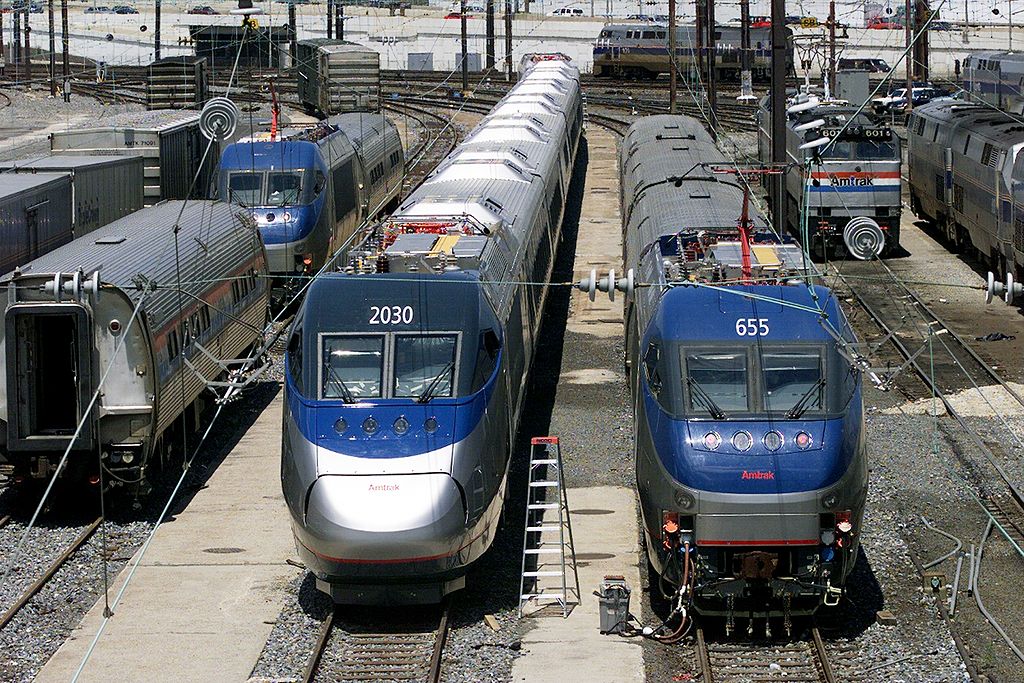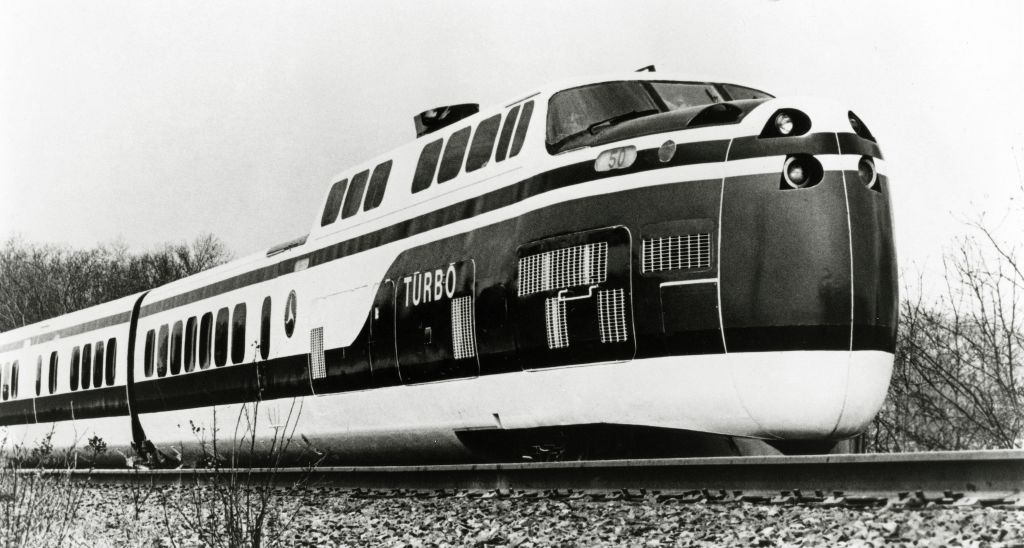
North America’s fastest train currently sits in a Philadelphia storage yard. Once slated to enter service in 2021, the next generation Acela Express will not carry passengers for at least another year. That’s according to an October report by Amtrak’s Office of Inspector General (OIG), which found that the train’s hydraulic systems leak, its couplers may corrode from draining water, and its windows sometimes shatter.
The OIG blames the French manufacturer, Alstom, for these problems while the company, whose share prices plunged almost 50% in the wake of the report and amid cash flow worries, faults poor track conditions on the northeast corridor between Boston and Washington, D.C.
The plight of the $2.3 billion Acela replacement program highlights several current policy issues: America’s decaying transit infrastructure, the scope of federal safety regulations, and the role of multinational corporations in an industry subject to 2021’s Build America Buy America Act. Though its trials seem ripped from the headlines, the slick French machine parked in Philadelphia also typifies America’s long, fraught history with fairly fast trains. This history teaches us that the country’s high-speed ambitions have long surpassed its willingness to pay for better railroads.
Over a century ago, U.S. locomotives paced the world. Thomas Edison boasted in 1882 that he could drive his new electromagnetic engine at 180 miles per hour “if I wanted to.” In 1893, the steam-powered Empire State Express actually broke 112 miles per hour on a straightaway near Buffalo. In 1934, the Chicago, Burlington and Quincy Railroad’s stream-lined Pioneer Zephyr completed an astounding “dawn to dusk” run from Denver to Chicago.
Trains lost their luster after World War II, when federal legislation favored private cars and commercial jets. In 1956, President Dwight D. Eisenhower signed a Federal-Aid Highway Act that committed $25 billion to building expressways for economic growth and national defense. In 1958, Congress passed legislation that created the Federal Aviation Administration to promote safer, more efficient flight at speeds no train could match.
More From TIME
Read More: Amtrak's Boss Has a Plan to Make You Love Trains Again. Will it Work?
But as train ridership dwindled at home, a rail revolution was fomenting abroad thanks to post-war reconstruction efforts underwritten by loans from the new World Bank. In 1964, Japanese National Railways began firing bubble-nosed electric trains over the Tokaido Shinkansen Line at 130 miles per hour. To Americans tuning into the Tokyo Summer Olympics, footage of bullet trains racing past Mount Fuji came as a revelation—a zero-altitude Sputnik moment that made many rethink the future of domestic transportation.
In 1965, Congress passed the High-Speed Ground Transportation Act, authorizing the Secretary of Commerce to research new “materials, aerodynamics, vehicle propulsion, vehicle control, communications, and guide-ways” that might bring Japanese-style advances to America. At the signing ceremony, President Lyndon Johnson marveled that “an astronaut can orbit the earth faster than a man on the ground can get from New York to Washington,” and promised to make public transit a “better servant of our people.”
To appease fiscal conservatives opposed to transportation budget increases, Johnson said that the Department of Commerce would work “in cooperation with private industry” to develop train designs at “no cost to the Government.” While this approach limited spending, it did not adequately account for the fact that fast trains needed dedicated tracks, welded rails, and new electrical power systems to tap their full potential. Without these improvements, America’s bullet trains would languish on the northeast corridor, an antiquated rail line already congested with freight and commuter traffic.
Instead of overhauling the corridor, the Ground Transportation Act funded two splashy demonstration projects. The first project resulted in a gasoline-powered Shinkansen look-alike called the TurboTrain. Engineered by the United Aircraft Company (UAC) and named after the Latin word for tornado, the TurboTrain employed the same Pratt and Whitney turbine technology that lifted planes and helicopters. On Dec. 20, 1967, a test Turbo whipped through Princeton Junction at 170.8 miles per hour, setting a North American rail speed record that still stands today.

The aerospace train performed less impressively in regular service between New York and Boston. Though passengers lauded the Turbo’s futuristic look and airline-inspired decors, the train averaged just 63 miles per hour on a winding track bed hampered by worn rails, cracked wooden ties, and many road crossings. Unable to reach full speed, the fuel guzzling turbine technology could not justify its operating cost. By 1976, UAC’s train of the future was rusting away on a spur beside the Providence River.
The Ground Transportation Act’s second demonstration featured the electric Metroliner, a stainless steel tube of a train that promised two-and-a-half hour trips over the Pennsylvania Railroad between New York and Washington, D.C.. Manufactured by General Electric, Westinghouse, and the Budd Company, the Metroliner reached 164 miles per hour on a trial run. Stuart Saunders, CEO of the Pennsylvania Railroad’s corporate successor, the Penn Central, crowed that the Metroliner’s 32-month development was “considerably shorter than the seven years of research, development, and testing which the Japanese required to initiate the Tokaido high-speed line.”

Saunders ate his words when the Metroliner proved a lemon. Its air compressor coils rattled. Its carriages wobbled on turns and heaved like merry-go-round horses. Metroliners sucked up ballast stones lining the corridor track bed and even ripped the windows out of an adjacent train. The Penn Central began staffing Metroliners with on-board technicians to fix problems en route.
In the end, design flaws, decrepit track, and American impatience doomed the Great Society’s trains. But Johnson’s budget-neutral template survived to guide later projects.
Read More: A Critical New York City Train Artery is in Desperate Need of Overhaul
In 2000, Amtrak debuted Acela Express, a silvery-blue electric trainset that adapted Alstom’s French TGV design to run on the northeast corridor’s rugged tracks. Alstom and its consortium partner Bombardier financed Amtrak’s purchase so that the cash-strapped railroad paid no money down. It even assembled the trains in two economically slumping American cities: Barre, Vt., and Plattsburgh, N.Y.

While these provisions helped sell the project, Acela never lived up to expectations. One problem was that the train needed to be bulked up to meet federal crashworthiness standards. Since Acela shared tracks with lumbering freights, it had to be able to sustain high-force collisions that could not happen on systems dedicated exclusively to passenger trains elsewhere in the world. Alstom engineers took to calling the train “cochon,” French for pig. Critics claimed that Acela trimmed time on routes mostly by skipping stops, noting that the train reached 150 miles per hour only on a short stretch of track in Massachusetts and Rhode Island.
The 21st-century global boom in passenger rail projects has shown how fast trains can boost perception of the countries that run them. State-of-the-art systems in China, Japan, France, Spain, Italy, Saudi Arabia, and South Korea have given their builders an air of stylish modernity. The U.S.’s frustrated pursuit of a bullet train, by contrast, reveals the perils of infrastructural compromises that make one set of tracks accommodate freight customers, commuters, and inter-city riders, and one train deliver profits while also serving the public good. Until public officials can decide what U.S. passenger trains should be—and who they must serve—the conditions that produced the star-crossed next-generation Acela project will temper the promise of American high-speed rail.
David Alff is the author of The Northeast Corridor: The Trains, the People, the History, the Region (due out in spring 2024 from the University of Chicago Press). He teaches in the English Department at SUNY-Buffalo. Made by History takes readers beyond the headlines with articles written and edited by professional historians. Learn more about Made by History at TIME here.
More Must-Reads from TIME
- Cybersecurity Experts Are Sounding the Alarm on DOGE
- Meet the 2025 Women of the Year
- The Harsh Truth About Disability Inclusion
- Why Do More Young Adults Have Cancer?
- Colman Domingo Leads With Radical Love
- How to Get Better at Doing Things Alone
- Michelle Zauner Stares Down the Darkness
Write to David Alff / Made by History at madebyhistory@time.com
